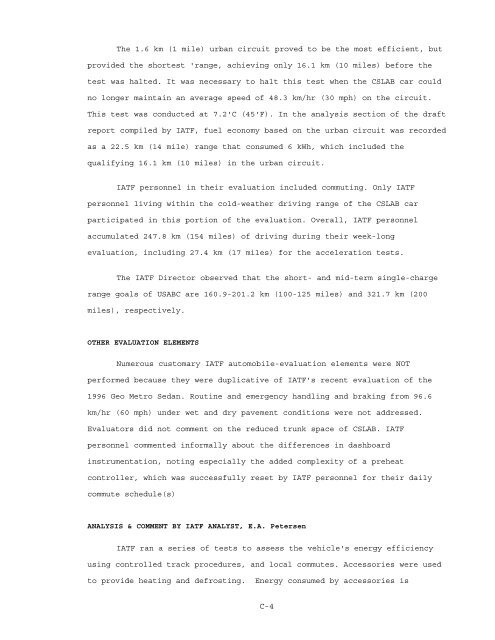Evaluation of Electric Vehicles as an Alternative for Work Trip and ...
Evaluation of Electric Vehicles as an Alternative for Work Trip and ...
Evaluation of Electric Vehicles as an Alternative for Work Trip and ...
Create successful ePaper yourself
Turn your PDF publications into a flip-book with our unique Google optimized e-Paper software.
The 1.6 km (1 mile) urb<strong>an</strong> circuit proved to be the most efficient, but<br />
provided the shortest 'r<strong>an</strong>ge, achieving only 16.1 km (10 miles) be<strong>for</strong>e the<br />
test w<strong>as</strong> halted. It w<strong>as</strong> necessary to halt this test when the CSLAB car could<br />
no longer maintain <strong>an</strong> average speed <strong>of</strong> 48.3 km/hr (30 mph) on the circuit.<br />
This test w<strong>as</strong> conducted at 7.2'C (45'F). In the <strong>an</strong>alysis section <strong>of</strong> the draft<br />
report compiled by IATF, fuel economy b<strong>as</strong>ed on the urb<strong>an</strong> circuit w<strong>as</strong> recorded<br />
<strong>as</strong> a 22.5 km (14 mile) r<strong>an</strong>ge that consumed 6 kWh, which included the<br />
qualifying 16.1 km (10 miles) in the urb<strong>an</strong> circuit.<br />
IATF personnel in their evaluation included commuting. Only IATF<br />
personnel living within the cold-weather driving r<strong>an</strong>ge <strong>of</strong> the CSLAB car<br />
participated in this portion <strong>of</strong> the evaluation. Overall, IATF personnel<br />
accumulated 247.8 km (154 miles) <strong>of</strong> driving during their week-long<br />
evaluation, including 27.4 km (17 miles) <strong>for</strong> the acceleration tests.<br />
The IATF Director observed that the short- <strong>an</strong>d mid-term single-charge<br />
r<strong>an</strong>ge goals <strong>of</strong> USABC are 160.9-201.2 km (100-125 miles) <strong>an</strong>d 321.7 km (200<br />
miles), respectively.<br />
OTHER EVALUATION ELEMENTS<br />
Numerous customary IATF automobile-evaluation elements were NOT<br />
per<strong>for</strong>med because they were duplicative <strong>of</strong> IATF's recent evaluation <strong>of</strong> the<br />
1996 Geo Metro Sed<strong>an</strong>. Routine <strong>an</strong>d emergency h<strong>an</strong>dling <strong>an</strong>d braking from 96.6<br />
km/hr (60 mph) under wet <strong>an</strong>d dry pavement conditions were not addressed.<br />
Evaluators did not comment on the reduced trunk space <strong>of</strong> CSLAB. IATF<br />
personnel commented in<strong>for</strong>mally about the differences in d<strong>as</strong>hboard<br />
instrumentation, noting especially the added complexity <strong>of</strong> a preheat<br />
controller, which w<strong>as</strong> successfully reset by IATF personnel <strong>for</strong> their daily<br />
commute schedule(s)<br />
ANALYSIS & COMMENT BY IATF ANALYST, E.A. Petersen<br />
IATF r<strong>an</strong> a series <strong>of</strong> tests to <strong>as</strong>sess the vehicle's energy efficiency<br />
using controlled track procedures, <strong>an</strong>d local commutes. Accessories were used<br />
to provide heating <strong>an</strong>d defrosting. Energy consumed by accessories is<br />
C-4
















